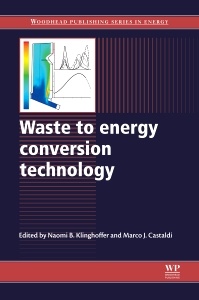Waste to Energy Conversion Technology Woodhead Publishing Series in Energy Series
Coordonnateurs : Klinghoffer Naomi B, Castaldi Marco J

Contributor contact details
Woodhead Publishing Series in Energy
Foreword
Part I: Introduction to waste to energy conversion
Chapter 1: Waste to energy (WTE): an introduction
Abstract:
1.1 Energy supply and waste management
1.2 Biogenic fraction of carbon and calorific value of municipal solid waste (MSW)
1.3 Thermal treatment of municipal solid waste (MSW)
1.4 Recycling and WTE
1.5 Contents of this book
Chapter 2: Environmental and social impacts of waste to energy (WTE) conversion plants
Abstract:
2.1 Introduction
2.2 Contributions of WTE conversion to waste reduction and energy generation
2.3 Air quality and residue management considerations of WTE conversion
2.4 Greenhouse gas profile of WTE
2.5 Compatibility of WTE with recycling
2.6 Health and safety aspects of WTE
2.7 Integrated planning for WTE plants
2.8 Future trends
Chapter 3: Lifecycle assessment (LCA) and its application to sustainable waste management
Abstract:
3.1 Introduction
3.2 Energetic comparison of waste to energy (WTE) systems and alternative waste options
3.3 Emissions comparison of WTE systems and alternative waste options
3.4 Advantages and limitations of using an LCA approach to evaluate waste management systems
3.5 An alternative metric to evaluate waste management systems that addresses goal-oriented needs
3.6 Sources of further information
Chapter 4: Feedstocks for waste to energy (WTE) systems: types, properties and analysis
Abstract:
4.1 Introduction
4.2 Types of feedstock for WTE systems and their characteristics
4.3 Testing of feedstocks for WTE systems
Part II: Waste to energy systems, engineering and technology
Chapter 5: Pre-processing and treatment of municipal solid waste (MSW) prior to incineration
Abstract:
5.1 Introduction
5.2 Basic screening processes: mass burn
5.3 Fuel upgrading and enhancement processes
5.4 Advanced screening, separation and processing
5.5 Shredding and size reduction processes
5.6 Conclusion
Chapter 6: Municipal solid waste (MSW) combustion plants
Abstract:
6.1 Introduction
6.2 Principles of combustion
6.3 Mass burn waterwall combustion systems
6.4 Refuse-derived fuel (RDF) combustion systems
6.5 Modular combustion systems
6.6 Advantages and limitations
6.7 New developments
6.8 Sources of further information
Chapter 7: Waste firing in large combustion plants
Abstract:
7.1 Introduction
7.2 Pulverised-coal (PC) units with direct co-firing
7.3 Direct fluidised-bed combustion
7.4 Co-combustion of gasification gas in a pulverised-coal boiler
7.5 Retrofitting a pulverised-coal plant with fluidised-bed units
7.6 Controlling high-temperature corrosion in co-fired units
7.7 Conclusion
Chapter 8: Waste to energy (WTE) systems for district heating
Abstract:
8.1 Introduction
8.2 Waste boilers
8.3 Electricity production in waste to energy (WTE) facilities
8.4 WTE facilities as sources of heat
8.5 Optimizing energy efficiency in WTE combined heat and power (CHP) facilities
8.6 Conclusion
Chapter 9: Gasification and pyrolysis of municipal solid waste (MSW)
Abstract:
9.1 Introduction
9.2 Gasification and pyrolysis
9.3 Products and their applications
9.4 Process analysis and reactor design
9.5 Process modifications for gasification systems
9.6 Environmental effect of gasification
9.7 Technologies in operation
9.8 Conclusion
Part III: Pollution control systems for waste to energy technologies
Chapter 10: Transformation of waste combustion facilities from major polluters to pollution sinks
Abstract:
10.1 Introduction
10.2 Status of waste combustion before 1970
10.3 Air emission regulations and their influence upon technology
10.4 Dioxin emissions
10.5 Environmental impact of emissions from modern waste combustion plants
10.6 Conclusion
Chapter 11: Air quality equipment and systems for waste to energy (WTE) conversion plants
Abstract:
11.1 Air quality considerations and regulations for municipal waste combustors
11.2 Acid gas scrubbing in municipal waste combustors
11.3 Particulate control devices utilized at waste combustion facilities
11.4 Control of nitrogen oxide emissions and hazardous air pollutants from waste combustors
11.5 Air pollution control cost–benefit analysis
11.6 Air quality technology innovations for municipal waste combustors
Index
Professor Marco J. Castaldi is Associate Professor of Chemical Engineering at City University of New York, City College (CCNY), USA. Professor Castaldi is active in the Materials and Energy Recovery Division of ASME and the Research and New Technology Council of AIChE; he has been involved in research and development in waste to energy and gasification technology for the last decade.
- Reviews the waste hierarchy and waste to energy systems options along with the environmental and social impact of WTE conversion plants
- Explores the engineering and technology behind WTE systems including considerations of municipal solid waste (MSW) its treatment, combustion and gasification
- Considers pollution control systems for WTE technologies including the transformation of wast combustion facilities from major polluters to pollution sinks
Date de parution : 05-2013
Ouvrage de 256 p.
15.5x23.3 cm



